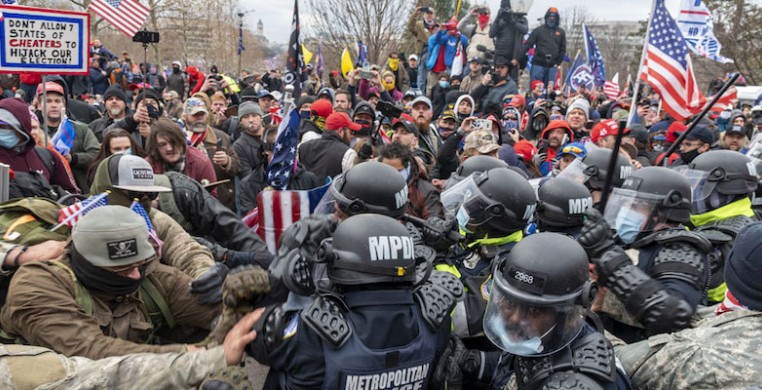I was on a lunch break. Tuning in via YouTube, I thought I’d catch up on the day’s events as the 2020 election was due to be certified by Congress, a governmental process I didn’t know existed until this year. Senator James Lankford of Oklahoma was arguing his case, hoping to persuade his colleagues, without evidence, that a grand conspiracy had taken place and that our election was fraudulent. Mid-sentence, everything changed.
Watching that day, and in the days after, I thought about how rage, distrust and the perception of disenfranchisement manifest in the body. Engrained mistrust, white supremacy and belief in Donald Trump’s lies drove American citizens to scale buildings and erect gallows, pushing and shoving like a Medieval mob in seek of vengeance and violently assaulting capitol police officers and members of the press.
“This is not who we are,” was the overwhelming sentiment of many elected officials, political commentators and columnists across the ideological spectrum. But of course, this is America. Nearly half of the country voted for more of the same, with the deep-seated belief that Trump and his cronies are looking out for them.
He’s obviously not, but I'm a dance writer and this is a dance column. With the coronavirus pandemic raging on and stage doors still locked, how does one make, perform and consume dance in 2021? Is a livestream of "Giselle" or another mediocre Zoom dance going to heal our broken souls?
Dance is not immune to political discourse. Because ours is typically a responsive artform, for better or worse, there will be piles of new dances created around this moment. Some audiences seek dance for escapism; others look to dance as an intellectual or spiritual pursuit to better understand ourselves and the world around us. For this critic, both of these reasons have merit. Trace the origins of most dance forms and you’ll find a mixture of entertainment, propaganda, spirituality and community.
But it’s important to remember that the choices choreographers make are guided, consciously or not, by their backgrounds, biases and assumptions, and privilege. Catalyzed by the Black Lives Matter movement, there’s work being done across the sector to increase equity. Theoretically, this fosters inclusion and creates access to dance for anyone who wants it.
Choreographers will do what they will with this moment artistically. But what of the patron model on which dance survives? Big questions abound, even before the pandemic, about dance’s reliance on the gig economy and the hospitality industry. Dance organizations, mostly non-profits, are literally charities, and therefore, by law, are supposed to be apolitical. While the commissioning structure usually doesn’t dictate what works get made, it is not beyond the realm of possibility that those with the deepest pockets will wield power over the creative process.
Until a better idea arises, these are the rules by which dance abides. It is exclusive and expensive. Access to dance does not ensure participation. Participation does not ensure persuasion of what is right and just. I’m assuming most of the rioters have watched “Dancing with the Stars” and done a conga line at a wedding. They also know what rage feels like. It took over and, in the worst way possible, it awakened their bodies.
Let me be clear. I’m not in any way condoning or sympathizing with the insurgents, be it the guy with his feet on Nancy Pelosi’s desk or the person who murdered officer Brian Sicknick or some curious bloke who simply stood outside the Capitol to observe. And I’m not suggesting that finding common ground is right or necessary, or that dance should find a way to get those particular butts in seats.
As we embark on a new year, that in six days went from hope and promise to, well, the opposite of that, I continue to lean into dance as a source of comfort and provocation. While I’m probably not the only one who wishes that it was happening in a plush armchair at the theatre, my lumpy couch will do for now. But there will be days when life itself is the dance. Some would say all of them are. Let us all—watchers and dancers alike—take care of ourselves in what promises to be... a year.

